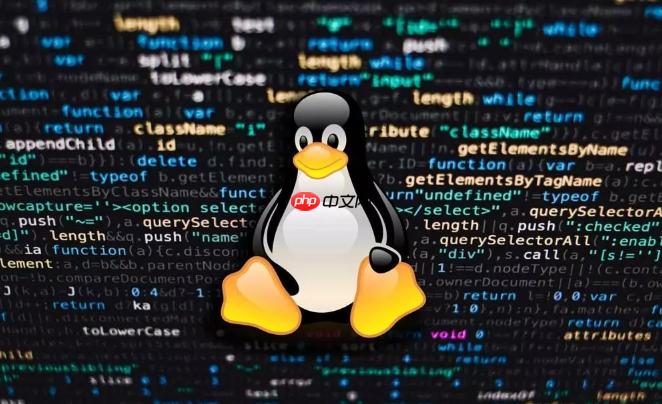Systemd服务依赖配置核心指令包括Wants(弱依赖)、Requires(强依赖)、After/Before(启动顺序)、Conflicts(互斥)和PartOf(分组),通过合理使用这些指令并避免循环或过度依赖,可确保服务按正确顺序启动且系统稳定运行。

在Linux系统中,要设置服务间的依赖关系,我们主要依赖Systemd——现代Linux发行版中广泛使用的初始化系统。简单来说,就是通过编辑或创建Systemd的单元文件(
.service
在Systemd中,服务依赖关系的配置主要通过修改或创建服务的
.service
/etc/systemd/system/
/usr/lib/systemd/system/
[Unit]
Wants=
Wants
Wants=network-online.target
Requires=
Requires
Requires=mysql.service
After=
After
After
After=network.target
Before=
After
Before
Before=httpd.service
Conflicts=
Conflicts
Conflicts=old-service.service
PartOf=
PartOf
配置步骤:
找到或创建服务文件: 通常,我们会在
/etc/systemd/system/
my-app.service
# /etc/systemd/system/my-app.service [Unit] Description=My Custom Application Service Documentation=https://example.com/docs Wants=network-online.target # 希望网络在线 After=network-online.target # 在网络在线后启动 Requires=mysql.service # 必须依赖MySQL服务 After=mysql.service # 在MySQL启动后启动 [Service] ExecStart=/usr/local/bin/my-app-server WorkingDirectory=/opt/my-app User=myuser Group=myuser Restart=on-failure [Install] WantedBy=multi-user.target
重新加载Systemd配置: 每次修改或创建
.service
sudo systemctl daemon-reload
启用并启动服务:
sudo systemctl enable my-app.service sudo systemctl start my-app.service
通过这种方式,Systemd就会根据你定义的指令,智能地管理服务的启动顺序和依赖关系。

在Systemd的世界里,理解这些指令的细微差别至关重要,它们决定了你的服务如何与其他系统组件协同工作。我个人在处理一些复杂的微服务部署时,就曾因为混淆了
Wants
Requires
Wants=
After=
Requires=
Requires
Requires
After=
After=
After
Requires
Before=
After=
Conflicts=
PartOf=
PartOf
PartOf
理解这些指令的含义和它们之间的微妙区别,能让你更精确地控制服务的生命周期,避免许多潜在的系统启动问题。我曾见过有人为了图方便,所有依赖都用
Requires

哎,说起来都是泪。我自己在运维生涯中,因为依赖设置不当踩过的坑可不少。最常见的,也是最让人头疼的,就是系统启动时服务无法按预期启动,或者干脆就卡死在那里。
Wants=mysql.service
After=mysql.service
Requires=
Requires=
Requires=
journalctl -u your-service
所以,在设置服务依赖时,真的需要深思熟虑,权衡利弊。既要保证核心功能的正常运行,又要避免因为次要组件的故障而拖垮整个系统。

配置复杂的依赖关系,往往涉及到对Systemd的深入理解,以及对你服务自身启动逻辑的清晰把握。我通常会把这个过程看作是构建一个精密的乐高模型,每个服务都是一块积木,而依赖关系就是连接它们的榫卯。
细化服务启动的生命周期: 在编写
.service
network-online.target
local-fs.target
network-online.target
RequiresMountsFor=/path/to/mount
利用target
target
multi-user.target
network-online.target
target
my-infra.target
# /etc/systemd/system/my-infra.target [Unit] Description=My Custom Infrastructure Target Wants=InfraService.service After=InfraService.service
然后,在ServiceA、ServiceB、ServiceC的
.service
# /etc/systemd/system/ServiceA.service [Unit] Description=Service A Requires=my-infra.target After=my-infra.target # ... 其他配置 ...
这样一来,所有的微服务都只需要依赖
my-infra.target
InfraService.service
my-infra.target
使用RequiresMountsFor=
RequiresMountsFor=/path/to/mount
.mount
.mount
# /etc/systemd/system/my-data-service.service [Unit] Description=Service that uses shared data RequiresMountsFor=/mnt/shared_data After=network-online.target # 如果是网络挂载,还需要网络 # ...
考虑服务启动的“就绪”状态: 仅仅依赖
After=
Requires=
Type=notify
sd_notify()
ExecStartPre
ExecStartPost
nc -z
RestartSec
StartLimitIntervalSec
Restart=on-failure
避免循环依赖和过度依赖: 在设计复杂的依赖时,务必检查是否存在循环依赖(ServiceA Requires ServiceB, ServiceB Requires ServiceA)。Systemd会尝试解决,但通常会导致启动失败或警告。同时,正如前面所说,避免过度使用
Requires=
通过这些方法,你就能构建出既健壮又高效的服务启动流程,让你的自定义服务在Linux系统上稳定运行。这就像指挥一个交响乐团,每个乐器(服务)都知道自己的出场顺序和与其他乐器的配合(依赖关系),最终奏出和谐的乐章。
以上就是Linux怎么设置服务依赖关系的详细内容,更多请关注php中文网其它相关文章!

每个人都需要一台速度更快、更稳定的 PC。随着时间的推移,垃圾文件、旧注册表数据和不必要的后台进程会占用资源并降低性能。幸运的是,许多工具可以让 Windows 保持平稳运行。

Copyright 2014-2025 https://www.php.cn/ All Rights Reserved | php.cn | 湘ICP备2023035733号